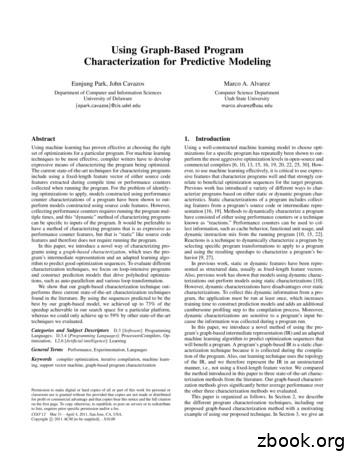Characterization And Story Structure In A World Of Danger .
It can be a moral turn: The lawyer who had previously taken a bribe to throw her casesuddenly starts to try the case honestly.*It can be a physical and moral turn: Just before a dangerous battle during war, a toughtalking soldier loses his nerve and chooses to hide himself under the dead bodies of hisfallen comrades to avoid being killed.When you create a scene with danger, you must have a turn. If the scene starts out morepositively, it should turn negative, and vice versa. A turn creates suspense, drama,excitement, and interest.Exercise #4: Share this prompt with your students.Go back to your bus outline or your outline where you reverse a scene. Is there a turn? Ifnot, create one. If there is a turn already, for practice, create another turn. Maybe reversethe scene in order to do it. Do you see the effects on characterization and structure? Howdoes it heighten the danger?Wrap-up: Characters show their true character when you escalate the amount of pressureyou put on them. A way to do this is through characterization combined with structure.Character and structure are often thought of as separate disciplines, but they can be oneand the same.Emphasize to Your Students: With character informing the structure of your scene orchapter, you can create a useful outline. Just ask your character about his or her choices,and they will tell you what to write. This is a sure way to get around writer’s block.
The exercises you worked on actually created story structure for your dangerous scene byusing characterization.Share these techniques to remember with your students:1. Use characterization to create structure.2. If a scene isn’t working, reverse it. If you want to keep the scene you’ve just reversed,go back and change prior scenes in your story to make the characterization consistent.3. Always include a turn in your scene work.Share this WORLD OF DANGER BOOKS reading list for students interested in seeingmore of these techniques used in practice:Long Way Down by Jason ReynoldsSadie by Courtney SummersAllegedly by Tiffany JacksonThis lesson plan was created by the author of Your Corner Dark, Desmond Hall. He hasworked as a high school biology and English teacher in East New York, Brooklyn;counseled teenage ex-cons after their release from Rikers Island; and served as SpikeLee’s creative director at Spike DDB. Desmond has served on the board of thePartnership for Drug-Free Kids and the Advertising Council and judged the One Show,the American Advertising Awards, and the NYC Downtown Short Film Festival. He’salso been named one of Variety magazine’s Top 50 Creatives to Watch.This lesson plan has been provided by Simon & Schuster for classroom, library, andreading group use. It may be reproduced in its entirety or excerpted for these purposes.For more Simon & Schuster guides and classroom materials, please visitsimonandschuster.net or simonandschuster.net/thebookpantry.
Characterization: Characterization is the process by which the writer reveals the personality of a character. The personality is revealed through direct and indirect characterization. Direct characterization is what the protagonist says and does and what the narrator implies. Indirect characterization is what other characters say about the
Nov 11, 2010 · User Story 1 User Story 2 User Story 4 User Story 5 User Story 5 (Cont.) User Story 3 User Story 6 User Story 7 rint 1 User Story 8 2 User Story 1 User Story 2 User Story 4 . Process Template Light on security artifacts/documentati on. OWASP Making SDL-Agile Manageable Toolin
characterization: direct characterization and indirect characterization. Direct Characterization If a writer tells you what a character is like the method is . Dr. Chang was the best dentist in the practice. He had a charming smile, a gentle manner, and a warm personality.
our characterization. Given this novel characterization, we can pro-duce models that predict optimization sequences that out-perform sequences predicted by models using other characterization tech-niques. We also experimented with other graph-based IRs for pro-gram characterization, and we present these results in Section 5.3.
3. Production Process Characterization 3.1. Introduction to Production Process Characterization 3.1.2.What are PPC Studies Used For? PPC is the core of any CI program Process characterization is an integral part of any continuous improvement program. There are many steps in that program for which process characterization is required. These .
Story Teller talks through their story, you will be listening out for these meaningful mo-ments that may inspire the Story Teller to re-connect with people, revisit special places or resume activities they enjoyed in the past. Sharing stories offers many benefits for the Story Teller and Story Listener. For the Story
Story Editor Overview Main editor for the users to create a story with multiple quests, chaining one to another to create a Story Set a banner photo, taken from your Photo Mode Gallery. Add a Story Name. Add a synopsis of your Story. Select the language that the Story is in. Select up to 5 more photos from your Photo Mode Gallery to serve as a gallery for your Story.
MODIS Calibration and Characterization for the Reflective Solar Bands (RSB) Jack Xiong and Bill Barnes (NASA/GSFC) RSB Group (MODIS Characterization Support Team) Ocean Color Calibration and Characterization Review Meeting, February 11-12, 2004. Outline EOS Instrument Background
he American Revolution simulation is designed to teach students about this important period of history by inviting them to relive that event . Over the course of five days, they will recreate some of the experiences of the people who were beginning a new nation . By taking the perspective of a historical character living through the event, students will begin to see that history is so much .























